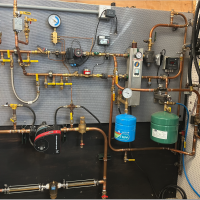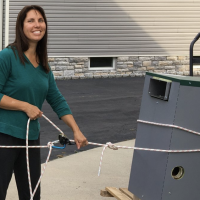Welcome! Here are the website rules, as well as some tips for using this forum.
Need to contact us? Visit https://heatinghelp.com/contact-us/.
Click here to Find a Contractor in your area.
If our community has helped you, please consider making a contribution to support this website. Thanks!
Best Of
Re: Zone 2 Upstairs Thermostat placement.
Of course the master bedroom is going to be too hot. So you will need to close the vents in that room.
Re: Leaking radiator flanges
If you put something other than dish soap or never seize on the mating faces, such as pipe dope or high temp silicone or some such, make sure the film is then and very very even. It's a last ditch solution.
One other thing. As noted, the union nut is soft -- almost always brass -- and it's very easy to squish it or break it. Tightening it beyond hand tight plus half a turn is NOT going to help.
One other thing. As noted, the union nut is soft -- almost always brass -- and it's very easy to squish it or break it. Tightening it beyond hand tight plus half a turn is NOT going to help.
Re: 1903 Times Square Construction: Is the White Cladding Here Insulation? or Just Brick?
It's the old NYTimes building, north of Flatiron by 15 blocks or so. Broadway created both buildings and the other triangle ones as it cuts at a small angle away from the N/S streets
It's the one that the New Year's ball is on!
https://en.wikipedia.org/wiki/One_Times_Square
It's the one that the New Year's ball is on!
https://en.wikipedia.org/wiki/One_Times_Square
Re: Expansion on heat-pex piping.
This is one reason that we use PEX-AL-PEX when provision for expansion is not available. It only grows about 1” per 100’ @ 100* temperature rise. Very similar to copper. With PEX, it’s about 12 times that.
 Ironman
Ironman
1
Re: Indirect Radiators
If this grand old house was uninsulated and fitted with "leaky" old windows the easiest solution might be to thoroughly insulate and weatherstrip (or possibly even change out for insulated low E) windows; this would:
A.) Greatly reduce your infiltration losses.
B.) Greatly reduce your transmission losses.
C.) Greatly reduce your radiation losses.
Your heating load will be cut by more than half; take half of the remaining indirect from the rear of the house and use it to heat the front, replace your old (presumably oil) steam boiler with a modern high efficiency steam boiler of half the size. I would be willing to wager these improvements will make for a much more comfortable (less drafty) house indwell pay for themselves in a matter of years
A.) Greatly reduce your infiltration losses.
B.) Greatly reduce your transmission losses.
C.) Greatly reduce your radiation losses.
Your heating load will be cut by more than half; take half of the remaining indirect from the rear of the house and use it to heat the front, replace your old (presumably oil) steam boiler with a modern high efficiency steam boiler of half the size. I would be willing to wager these improvements will make for a much more comfortable (less drafty) house indwell pay for themselves in a matter of years
gas pressure
Hi, we recently had a plumber doing work in our house to fix a gas leak. Our main gas line was turned off by the gas company due to the leak. In order to test the pipes, he applied 10 psi against our appliances. My question is can this damage the appliances (furnace, oven, water boiler) if done for a short time? And he found multiple leaks after fixing the first one- can that have been caused by applying more pressure than the pipes can handle during his testing?
Thank you!
Thank you!
1
Re: Solar Radiant Heat for Airplane Hangar
Assuming you do not have any or much passive, here are some solar thermal numbers.
First knowing the load would be helpful. Assume 15 btu/ ft to maintain 60°, X 3100 46,500 BTU/hr.
Reasonable winter temperatures in Reno, mid 30's oct- Feb.
The solar collector output is all about the ambient temperature around them.
This graph shows 3 types of collectors and the formula for calculating efficiency.
Assume the temperature to the collector from the building is 95F- 35F ambient. Collector supplying about 100- 105°F
Divided by the radiation, 200 is a realistic winter time radiation number, summer may see up to 300.
So Ti- Ta. 95°- 35° divided by 200 =.3
On the bottom axis, find .3 run straight up to the collector slope. So a glazed flat plate would run about 45% efficient on that winter day. Unglazed collector, about 0%, sorry it just cannot overcome that 35 ambient.
it just cannot overcome that 35 ambient.
At the SRCC website you can pull down collector rating. Here is a typical 40 sq ft SunEarth spec.
Use cat. D for heating, so somewhere between 5- 15,000 BTU per DAY (6 hours) from a 4X10 collector
You need 46,500 BTU per HOUR. So about 800 sq.ft of collector gets you close. 20 collectors at around $800.- 1000. For maybe 6 hours of a design day load. You still have 18 hours of no sun heating to cover per day.
I've spent a lifetime trying to make solar thermal pencil out for heating. Even with wholesale cost on copper fin, glass and aluminum and making them yourself it doesn't pencil out.
The solar contractors I know shoot for maybe a 30% SF solar fraction. Cover 30% of the heating load. But the installed cost still puts it in the 1% ers price range.
When incentives were in place covering up to 50% of installed cost, ROI was still 15- 20 years out on a even a basic basic 2 panel DHW system.
Harvest all summer coast all winter? Maybe. This apartment building in Switzerland does it. Got $$ and room for about 50,000 gallons of insulated storage and 3000 sq ft of collector?
First knowing the load would be helpful. Assume 15 btu/ ft to maintain 60°, X 3100 46,500 BTU/hr.
Reasonable winter temperatures in Reno, mid 30's oct- Feb.
The solar collector output is all about the ambient temperature around them.
This graph shows 3 types of collectors and the formula for calculating efficiency.
Assume the temperature to the collector from the building is 95F- 35F ambient. Collector supplying about 100- 105°F
Divided by the radiation, 200 is a realistic winter time radiation number, summer may see up to 300.
So Ti- Ta. 95°- 35° divided by 200 =.3
On the bottom axis, find .3 run straight up to the collector slope. So a glazed flat plate would run about 45% efficient on that winter day. Unglazed collector, about 0%, sorry
At the SRCC website you can pull down collector rating. Here is a typical 40 sq ft SunEarth spec.
Use cat. D for heating, so somewhere between 5- 15,000 BTU per DAY (6 hours) from a 4X10 collector
You need 46,500 BTU per HOUR. So about 800 sq.ft of collector gets you close. 20 collectors at around $800.- 1000. For maybe 6 hours of a design day load. You still have 18 hours of no sun heating to cover per day.
I've spent a lifetime trying to make solar thermal pencil out for heating. Even with wholesale cost on copper fin, glass and aluminum and making them yourself it doesn't pencil out.
The solar contractors I know shoot for maybe a 30% SF solar fraction. Cover 30% of the heating load. But the installed cost still puts it in the 1% ers price range.
When incentives were in place covering up to 50% of installed cost, ROI was still 15- 20 years out on a even a basic basic 2 panel DHW system.
Harvest all summer coast all winter? Maybe. This apartment building in Switzerland does it. Got $$ and room for about 50,000 gallons of insulated storage and 3000 sq ft of collector?
 hot_rod
hot_rod
3
Expansion on heat-pex piping.
I was looking for some input from the group how they handle expansion on long runs of heat-pex tubing. This is for a snowmelt job that has a run approximately just under 100ft of 1 1/4" from the point of exit of the house to a 4 loop manifold. I ran the 1 1/4" heat-pex tubing in a 3' PVC conduit for the total run. Every time the snowmelt goes on the piping in the basement expands approximately 5"-6". I used expansion fittings for my connections. Just concerned over time they may leak because of the movement of back and forth. Spoke with Uponor and they told me not to be concerned, but we all have heard that before.
Re: Is there a two pipe steam doctor in the house?
After reading your reply 63-04 you say ,well I doubt I would have risked a 2 inch header , as stated I get beaten all the time by the all 2 inch header installer yeah it’s much cheaper but it ain’t better . As for wanding and cleaning ah yeah chemicals ain’t gonna do it . If piped properly and clean the water line shouldn’t bounce more then 1/2 inch durning the cycle . I would suggest your boss be the one who deals w it he sold it and he did the 2 inch header and should have honestly cleaned after the first steaming and then one or two return visits to ensure it’s clean . It s really part of the job which most shrug off and state that’s the way steam is well I’m here tell ya that ain’t the way it’s suppose to be . It looks from the eq drop that skimming wasn’t gonna happen when you pipe your eq drop in front of the skim port it’s highly unlikely it was in the thought pattern and really over looked . It’s a pet peeve of mine to make sure the skim port can be used other wise it serves zero purpose . The use of the standard boiler drains are crap I usually throw them in my brass scape and install full port ball valve for reverse flushing and removing all the crap the always returns when a new boiler is installed . It isn’t some thing that happens w just about every steam boiler ,multi returns visits to get the system clean,again personally the most common issue w mis behaving steam boiler is bad piping ,not cleaned . This is really the second half of the job and the one most don’t price in until beaten badly then they learn . Just like undersized header and wet steam there common and a lot of system will operate but as I always say never what they should be and the biggest thing the in knowing your successful in your install is when customer never knows weather the heat is on or off they just know that there comfortable . This what we all should aim for being we are all in the indoor comfort business ?I just saw you're in Mahwah. So are we. I work at Bolkema Fuel.
Peace and good luck clammy
I agree that installs should be done to best practices. We're learning on the job here. I've asked for training and my boss just says "get it done". I've told him our training methods are like that of a mother bird. She pushes the babies out of the nest and says "fly baby bird".
Since the boiler is less than a year old, and we've drained the system a few times, do you think there's any reason to skim and wand the boiler?



